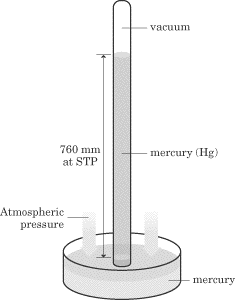\[10^5 M/m^2\]
and 'standard atmospheric pressure at sea level' is defined as \[1.01325 \times 10^5 N/m^2\]
.We can measure atmospherc pressure using a barometer.

\[P_{Atmospheric}= \rho gh\]
.The density of mercury is 13600 kg/m3, g=9.8 m/s2, h=760mm=0.76m, then
\[P_{Atmospheric}=13600 \times 9.8 \times 0.760=1.012928 \times 10^5N/m^2\]
.Atmospheric pressure is due to the earth pulling down the air towards the ground, and is equivalent to ten medium sized family cars to every square metre. You do no feel this force because atmospheric pressure acts in all directions - down, upwards and sideways, and almost cancel each other out.